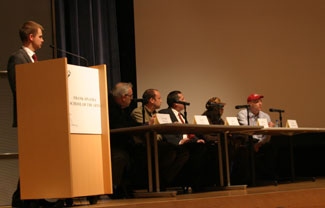
Led by moderator Christopher Wisniewski (left), members of the production gathered at Frank Sinatra School of the Arts to disucss their roles in the making of the film Enchanted. Photo courtesy of MOFTB.
|
January 4, 2010 - On a recent afternoon in December, local high school students got the chance to hear exactly what goes into shooting a complicated musical sequence and the many jobs it takes to accomplish making a film in New York City. Presented by the Mayor’s Office of Film, Theatre and Broadcasting and Museum of the Moving Image, “Anatomy of a Scene: Enchanted” introduced students to a variety of behind-the scenes jobs as they listened to crew members share their insights into how the Disney feature shot on the streets of New York at a special panel discussion at Frank Sinatra School of the Arts in Astoria, Queens.
Christopher Wisniewski, the Museum's Director of Education, served as moderator for the event and began by asking the panelists how they came from various walks of life before working in the film industry. Brooklyn native Maria Torres started as a dancer and began working in films as an associate choreographer in 2002. Jason Farrar, Enchanted’s assistant location manager, went to school for music and was selling guitars before he made the switch to film.
George DeTitta, Jr, the production’s set decorator, explained that his job is to help the director with his vision. For Enchanted, it was his job to decorate the set using items that helped blend the fantasy world with the real world. “You have to figure out logistics,” he said, “how much time do we get on the set to prepare.”
Farrar joined the team early on when the film was still in pre-production. He worked with the director, producer, and production designer as they tried to figure out what type of locations to use. He then coordinated with MOFTB, securing permission to film at public and private locations, and worked with the community to provide seamless on location shooting.
“Your job is to make it happen,” said Farrar. “You’re not in a backlot, you’re working in a city where people are going to their jobs. We have to be aware that people need to be able to get back and forth between their homes and jobs.”
Enchanted is a prime example of the level of collaboration that goes on between a production and the City. Dean McCann, MOFTB’s executive director of production, explained how the agency and the production met early in the process and pulled together other City agencies as they planned the scene in which the main character Giselle climbs out of a manhole in Times Square.
“DEP popped five manholes so we could evaluate them,” said McCann. “The final selection was a manhole that was good for the film because it had Times Square in the background and good for the City because it was a safe manhole that was closed off with assistance from the NYPD Movie/TV Unit.”
As the associate choreographer, Torres and choreographer John O’Connell were responsible for casting and rehearsing hundreds of dancers for the film as well as scheduling the elaborate Central Park musical sequence. The scene included 115 dancers and 500 extras, all of whom rehearsed at the Roseland Ballroom prior to filming.
“Five seconds of song took days to film,” she remembered. The complicated process was made easier by filming the big finale with all the different groups – seniors, brides and grooms, puppeteers, musicians, construction workers – first. That way, explained executive producer Ezra Swerdlow, each additional day could be broken down into a section. “Those smaller sections could be done on days with less perfect weather,” he said.
“I was inspired by the music,” said Torres. She was also proud that she was able to bring a multicultural look of New York City and keep the film’s fantasy element present. The production was something Torres will never forget. “It helped expand my career.”
“It’s my job is help put the film together,” said Swerdlow. He equates being a line producer with manufacturing the film. “You’re managing the expectations of the creative team with the financial side of things.”
The panelists also offered career advice to the aspiring high school students in the audience. All of the panelists encouraged the students to take opportunities as production assistants and interns. Swerdlow suggested the students take advantage of the technology that’s available to make films from home. “You can shoot it, cut it and put music to it all on your computer,” he said, noting such an opportunity didn’t exist a few years ago.
“You have to work really hard,” said DeTitta. “When people see that, they’ll hire you. You have to make that first impression. Bring passion to your work.”
McCann suggested thinking outside the box. “Be proactive. People do notice when you do a good job.”
“It’s one of the few industries that still has that ‘get your start in the mailroom’ mentality,” added Farrar. “You’re hired to run errands, make coffee. When you’re making your boss’ job easier, you’re doing something invaluable.”


